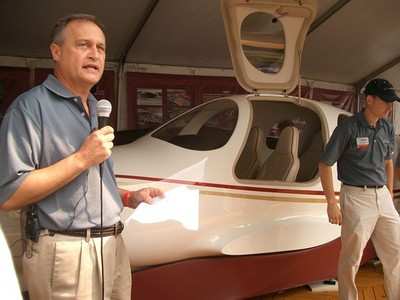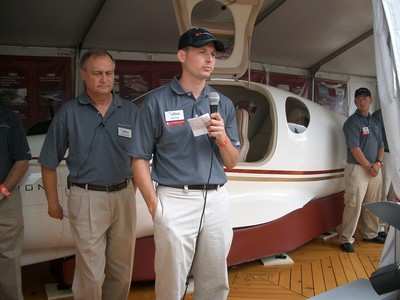Wed, Jul 25, 2007
Taking Personal Aircraft To A New Level
Safety and performance. Lancair has been doing it for 23 years,
delivering high performance piston and turbine powered aircraft
kits.

Surrounded by press and fans, Lancair unveiled Evolution at
AirVenture. Engineering on Evolution began three and a half years
ago. Lancair President Joe Bartels (above) makes no apologies for
the length of time spent on the design. "We did not take the fast
track approach with this design as many manufacturers have done so
in the past."
The Evolution is a product of technology, it was developed
entirely through Computer Aided Design created by Computer Numeric
Code machining and evaluated by Finite Element Analyses.

Some of the self imposed goals to meet; more space, meet FAR
Part 23 standards, including a 61kt stall speed while upholding the
Lancair reputation. Lancair's goal according to Bartels is to
"maximize uniformity and safety while still providing a kit that
our customers enjoy building."
Some of the safety features include BRS parachute system, energy
absorbing seats and AmSafe Aviation airbag seatbelts. "We took the
time necessary to come up with the best and safest four-place
turbine aircraft today," says Bartels.

Under the cowling lies a Pratt and Whitney PT6A-135A allowing
speeds in excess of 385 mph true using the four bladed Hartzell
prop. All this while sipping only about 35 gallons of Jet A per
hour. The range of Evolution with 45 minute reserve at max cruise
is 860nm and 1290 at economy cruise. Evolution will be ready to
take you places after about 1,000 hours of build time.
The Evolution is a true four seater. Four occupants, 140 gallons
of Jet A, 150 lbs of bags and still be below 4,300 lbs. Lancair
engineer Tony Ong comments on the 39 cubic feet of baggage space
and even more with the rear seats removed "if you wanted to camp
back there you could." The pressurized baggage door allows for the
addition of the family pooch and no mess from the packed toothpaste
tube. The instrument panel can be a Chelton EFIS or Garmin
G-900X.

The first five kits were ready for sale here at AirVenture and
by the end of the Evolution's debut only one was left. Construction
has started on the initial five and are scheduled to be delivered
before year end. After that the tooling and fixtures will be sent
off to the Philippines for full production run.
More News
Aero Linx: Aviators Code Initiative (ACI) Innovative tools advancing aviation safety and offering a vision of excellence for aviators. The ACI materials are for use by aviation pra>[...]
Make Sure You NEVER Miss A New Story From Aero-News Network Do you ever feel like you never see posts from a certain person or page on Facebook or Instagram? Here’s how you c>[...]
From 2016 (YouTube Edition): Who You Gonna Call When You Have a Rocket Engine that Needs a Spacecraft? While at EAA AirVenture 2016, ANN CEO and Editor-In-Chief, Jim Campbell, sat >[...]
"In my opinion, if this isn't an excessive fine, I don't know what is... The odds are good that we're gonna be seeking review in the United States Supreme Court. So we gotta muster>[...]
Expedite Used by ATC when prompt compliance is required to avoid the development of an imminent situation. Expedite climb/descent normally indicates to a pilot that the approximate>[...]
 ANN's Daily Aero-Linx (04.30.25)
ANN's Daily Aero-Linx (04.30.25) ANN FAQ: Turn On Post Notifications
ANN FAQ: Turn On Post Notifications Classic Aero-TV: Agile Aeros Jeff Greason--Disruptive Aerospace Innovations
Classic Aero-TV: Agile Aeros Jeff Greason--Disruptive Aerospace Innovations Aero-News: Quote of the Day (04.30.25)
Aero-News: Quote of the Day (04.30.25) ANN's Daily Aero-Term (04.30.25): Expedite
ANN's Daily Aero-Term (04.30.25): Expedite






